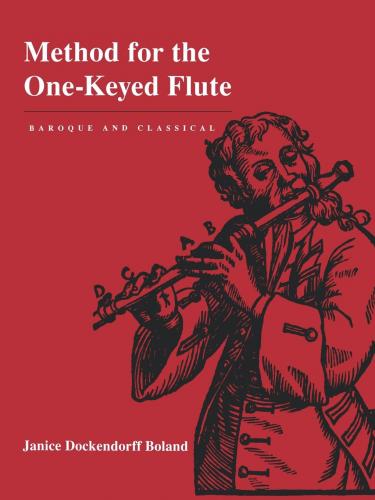How is the flattement used?
The flattement with the messa di voce
Notation
Are we certain that breath vibrato was not used?
Recommended readings
On Intonation
How to tune
Playing “in tune”
Enharmonic notes
Practical application
Practicing good intonation
Adjusting for intonation
On Playing Forte and Piano
Using the screw cap
On Rhythmic Hierarchy
“Good” notes, “bad” notes
Practical application
Quick notes
Beating time
Recommended readings
On Articulation
Articulation silences
Unslurred notes
Eighteenth-century patterns for quick notes
Double tonguing
Recommended readings
On Further Readings
CHAPTER III FINGERINGS FOR THE ONE-KEYED FLUTE
On Fingerings
Why so many choices?
Lowering the pitch
Use of the key
Extending the range
Alternate f sharp
How many fingerings?
On Trills
Wide Trills
Execution
Recommended readings
Explanation of the Charts
Basic Fingering Chart
Complete Fingering Chart
Table of Trills
Flattement Chart
CHAPTER IV EXERCISES AND TUNES TO PLAY
About the Music
Duet playing
Exercises and Tunes (Eighteenth-Century Sources)
D Major
G Major
e minor
A Major
CHAPTER V MODERN STUDIES FOR ONE-KEYED FLUTE
Introduction to Modern Studies
Practice Routine
Modern Exercises Major sequences for the one-keyed flute
Broken chord studies in the major keys
Broken chord studies in minor keys
APPENDIX A THE “TOP 13” EIGHTEENTH-CENTURY FLUTE TUTORS
APPENDIX B ON REPERTOIRE FOR THE BEGINNING ONE-KEYED FLUTIST
Easy solos
Collections
Studies
Easy Duets
ANNOTATED BIBLIOGRAPHY: BEFORE 1853
AFTER 1853
PREFACE
Musicians today are caught up in a movement to study and explore the use of old musical instruments. The flute generating the most interest is the eighteenth-century one-keyed flute. A growing number of flutists are purchasing modern replicas and learning to play them.
Not long ago the one-keyed flute was considered an inadequate predecessor of the modern flute. In 1966 René LeRoy (p. 14) described the eighteenth-century flute as a “very imperfect instrument.” The writer of a doctoral essay at Eastman said that the one-keyed flute's inferior pitch quality and inferior tone quality were natural and unavoidable flaws in the instrument (Hartman, 1961, p. 16). Generally, flutists had no desire to learn to play this simple one-keyed instrument when a “perfected” flute was available to them.
However, attitudes have changed during the past thirty to forty years. Concerts and professional recordings featuring historic flutes are no longer rarities. Workshops specializing in the manufacture of historical flutes and music publishers specializing in scholarly editions of early music support these performance activities.
Flutists who experiment with the one-keyed flute find that it is indeed an instrument of merit. Innate in the simplicity of its structure are unique expressive qualities not inherent in the modern Boehm-system flute.
This method book is written for players of the Boehm-system flute who are already familiar with tone production and modern flute technique: it is designed to help with the flutist's initial approach to the one-keyed flute. The Method can serve as a self-guiding tutor or as a text when the flutist is working with a teacher. It is not intended to be a musicological treatise, but a practical and useful guide which cites historical sources. These historical sources offer a broad diversity of opinions which challenge us to explore the ideas of eighteenth-century writers and incorporate them into our present-day experience.
The Method addresses such topics as choosing a flute and assembling the instrument, to more advanced concepts such as tone color and eighteenth-century articulation patterns. Discussions of tone, intonation, and tonality will help guide the student in exploring the expressive nature of the instrument. Fingering charts, exercises, and eighteenth-century tunes will help the student get started. To encourage the reader to explore primary historical sources, the “Top 13” eighteenth-century flute tutors are reviewed with reference given to present-day facsimile editions and translations. Those new to the one-keyed flute will be helped by the annotated repertoire list of easy solos, duets, and studies. The annotated bibliography references both historical and modern sources.
Many texts on eighteenth-century technique and style are currently available, both as primary sources (from eighteenth-century authors) and secondary sources (in this case, twentieth-century writings regarding eighteenth-century performance style). The scope of this book does not allow for any more than a mention of some of the more important techniques and performance styles. Textbooks and articles by leading scholars are referenced throughout the text and included in the annotated bibliography to encourage the reader to become familiar with these important sources.
Your reasons for exploring the one-keyed flute may range from mere
